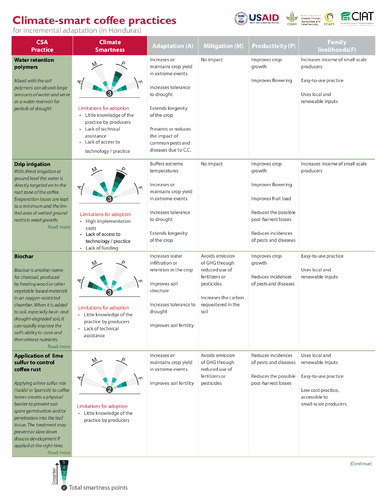Climate Smart coffee in Honduras
Honduras is now the largest coffee producer in Central America. Low cost of production, generational change and institutional support resulted in an average annual production growth of 5%. About 110,000 families have coffee as a primary income. 95% of these are smallholders with less than 7ha. Coffee provides employment to an estimated 1 million people.
The bulk of production is higher quality Arabica coffee which is highly vulnerable to climate change. Most production is shaded at altitudes above 900masl. Many plantations were recently renovated but remain susceptible to major climate driven diseases. Most coffee producers diversify their income sources and crops because a failed coffee harvest may result in enduring malnutrition.
Coffee production areas in Honduras have become drier and hotter over the past three decades. Annual temperatures have risen across the country, potential evapotranspiration increased and the distribution of precipitation has become more variable. These trends likely increased the water needs of the coffee crop.
Climate model projections show an unambiguous trend to higher temperatures at coffee locations. The seasonal distribution of rainfall will likely remain similar.
Precipitation amounts during the dry season should remain similar to current conditions. May precipitation may increase compared to current conditions with possible reductions in the following months. However, a wide range of projections reflects the difficulty to predict future precipitation. Projected temperature increase and mean reduction in precipitation make droughts more likely and potentially more severe for coffee production. Stakeholders should prepare for more efficient water management.
To support efficient adaptation, we developed a coffee specific evaluation of the projected climatic changes described above. Previously sub-optimal sites will likely become uneconomical for coffee. This trend is evident in the gradual disappearance of Honduran Standard grade coffee in the last decade.
High grown grade coffee will struggle to remain productive unless comprehensive adaptation measures are implemented. Strictly high grown grade will require incremental management changes to remain productive.
Areas above 1800masl may become attractive for coffee production in the future but measures should be taken to exclude protected areas from value chains and ensure sustained provision of key ecosystems services that underpin productivity.
Different degrees of impact require different adaptation strategies. Adequate varieties, improved shade cover and cover crops are the minimal CSC practices required. With increasing degree of impact mulch, temporary shade, living hedges, windbreaks should be added to the system. Where drought is increasingly problematic drip irrigation, water harvesting, soil enhancing polymers or biochar are recommended. In addition to improved agronomic management, progressive climate change will make a diversified income from alternative crops, off farm income or crop insurance necessary.
Adaptive action at scale needs to be taken immediately, and with a forward-looking approach. Coffee production is an investment of several decades and many CSC practices have a long lead-time. About 85% of Honduran farmers are associated with institutions but the training benefits received are often inadequate. Local institutions are understaffed or struggle to act as agents of innovation. A multi-stakeholder approach will be required as no single technology or scaling pathway may account for the diversity of decision environments of the actors involved.
We suggest four alternative scaling pathways for climate smart coffee: Voluntary certification, carbon in setting, impact investing, and private sector training.

